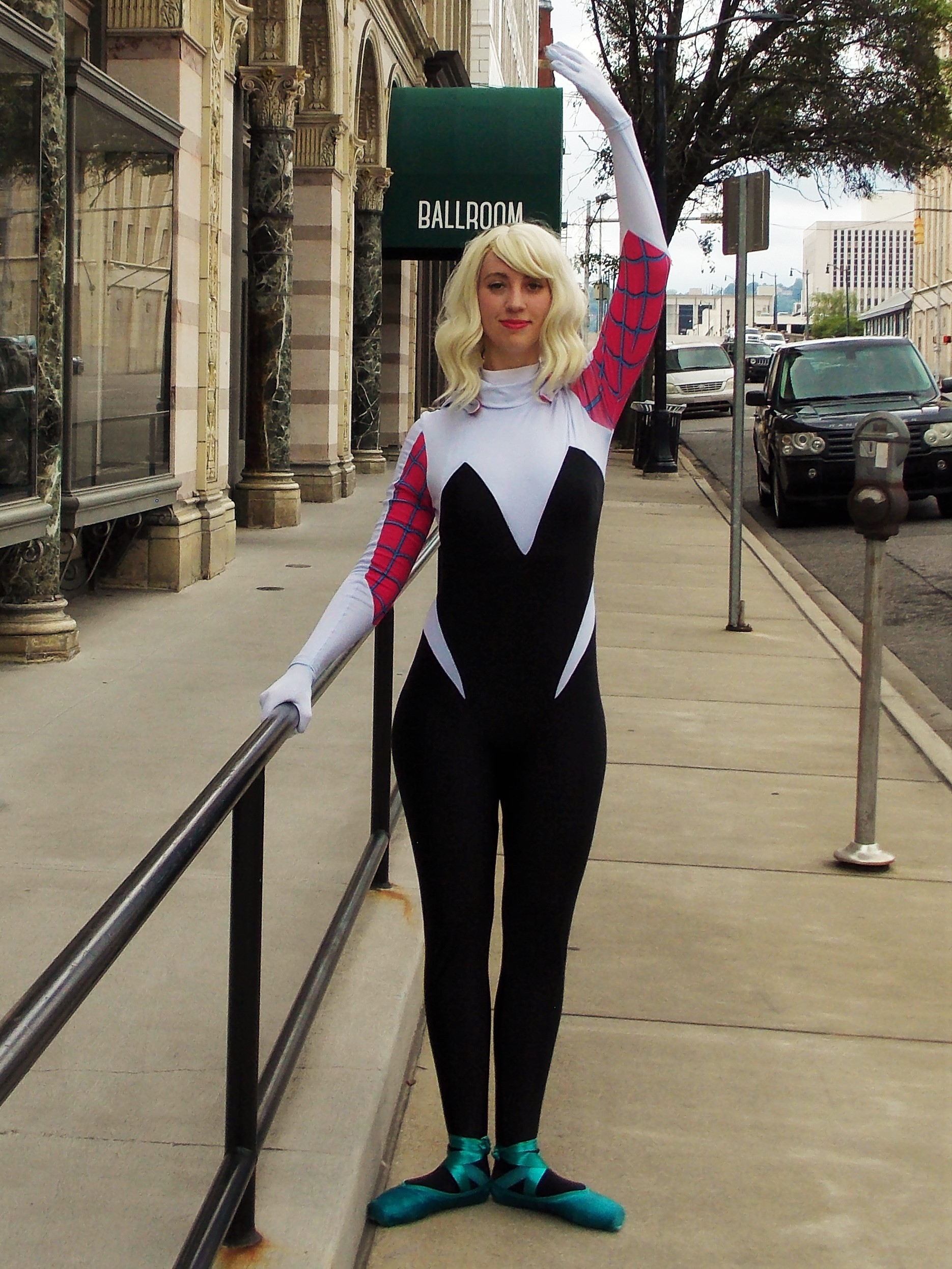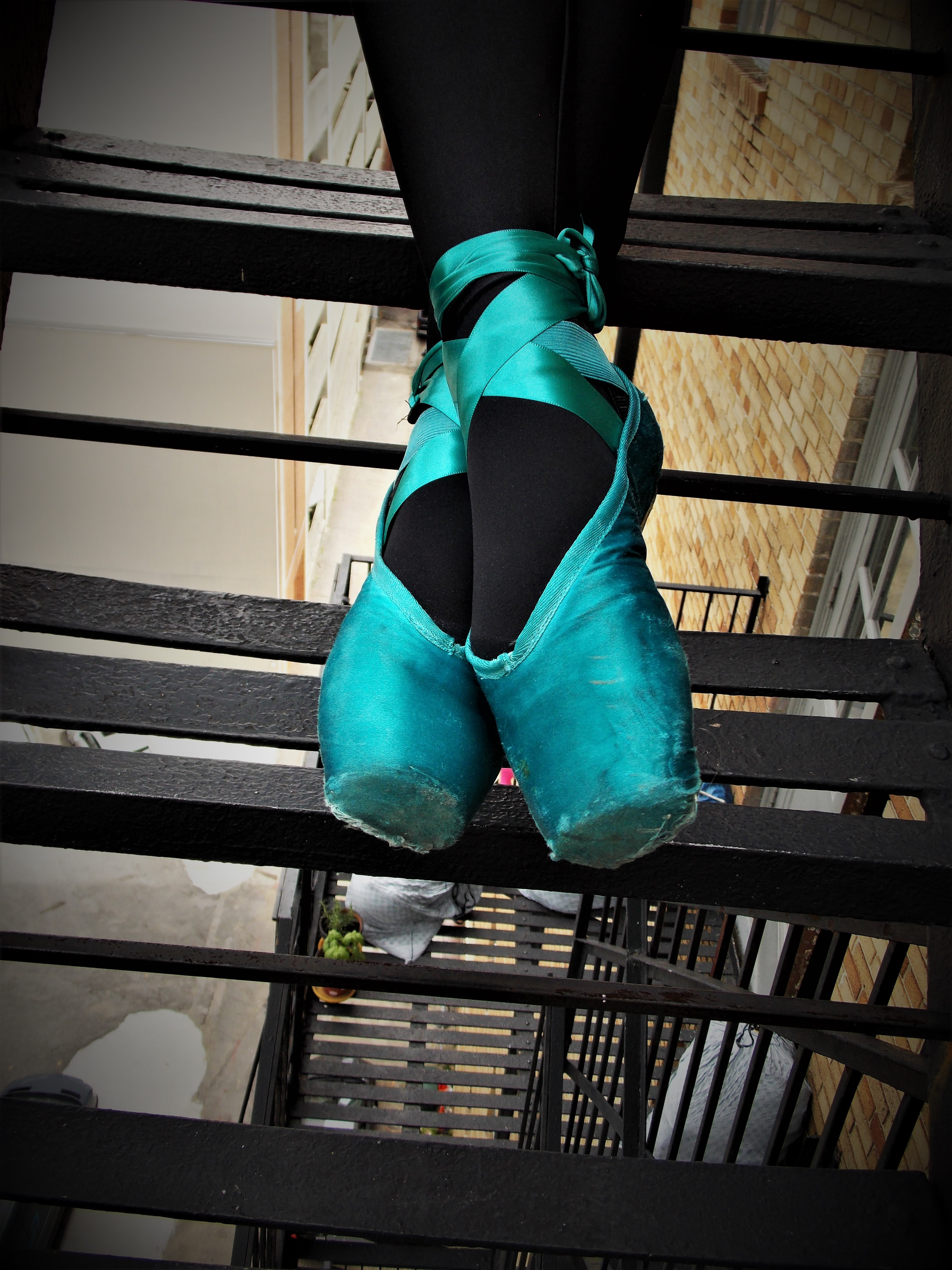Is Spider-Gwen a dancer? Absolutely, Spider-Gwen embodies the grace and athleticism often associated with dance, inspiring many to explore the art of movement; at ten-dance.com, we help you channel your inner Spider-Gwen, whether you’re a seasoned dancer or just starting out, and help you learn more about ballet techniques, flexibility training, and creative posing. Let’s swing into the world of dance and discover how you can capture Spider-Gwen’s spirit.
1. Who is Spider-Gwen and What Makes Her Dance-Like?
Spider-Gwen, also known as Ghost-Spider, is a popular Marvel Comics character known for her unique style and abilities. Her movements often reflect a dancer’s grace, agility, and control, making her an inspiring figure for dancers and cosplayers alike.
- Acrobatic Prowess: Spider-Gwen’s acrobatic skills, essential for swinging through the city and battling villains, mimic the flexibility and precision found in dance.
- Costume Design: Her iconic costume, including the blue pointe shoes, is a direct nod to ballet, symbolizing her blend of superhero action and dance aesthetics.
- Character Inspiration: Spider-Gwen inspires individuals to explore their own potential and combine different passions, much like integrating dance into a superhero persona.
2. Does Spider-Gwen Practice Ballet?
While not explicitly stated in the comics, Spider-Gwen’s fighting style and character design strongly suggest a background in ballet. Her creator, Jason Latour, has implied elements of dance influence.
- Graceful Movements: Her movements are fluid and graceful, resembling the elegance of a ballet dancer.
- Pointe Shoes: The inclusion of pointe shoes in her costume emphasizes a connection to ballet.
- Symbolic Representation: Ballet represents discipline, precision, and artistry, all of which align with Spider-Gwen’s character traits.
3. How Can You Recreate Spider-Gwen’s Dance-Inspired Poses?
Recreating Spider-Gwen’s poses involves understanding basic dance positions and adapting them to suit her dynamic character. Here are some tips to help you strike the perfect pose:
- Master Basic Positions: Learn the five basic feet positions in ballet to provide a foundation for your poses.
- Focus on Flexibility: Incorporate stretches to improve flexibility, allowing for more expressive and dynamic movements.
- Use Props: Utilize props such as chairs, walls, or handrails to enhance your poses and add a creative touch.
4. What Are the Five Basic Feet Positions in Ballet?
Understanding the five basic feet positions is crucial for emulating Spider-Gwen’s dance-like movements. These positions form the foundation of classical ballet and provide a sense of structure and elegance to your poses.
- First Position: Heels touching, toes turned outwards.
- Second Position: Feet shoulder-width apart, toes turned outwards.
- Third Position: Heel of one foot touching the inside arch of the other foot.
- Fourth Position: One foot in front of the other, toes turned outwards, with a separation between the feet.
- Fifth Position: One foot in front of the other, with the heel of the front foot touching the toe of the back foot, toes turned outwards.
 First position
First position
5. How Can You Use Pointe Shoes for Spider-Gwen Cosplay Without Dance Training?
Pointe shoes are a signature element of Spider-Gwen’s costume, but they can be dangerous without proper training. Here’s how to use them safely for cosplay:
- Focus on Posing: Emphasize poses that do not require full weight on the toes.
- Get Professionally Fitted: Ensure the shoes fit properly to prevent injuries.
- Use Toe Pads: Cushion your toes with toe pads to reduce discomfort.
- Avoid Stunts: Refrain from attempting any stunts or movements that could lead to injury.
6. What Kind of Toe Pads Should I Use Inside Pointe Shoes?
Choosing the right toe pads can significantly enhance comfort and reduce the risk of injury when wearing pointe shoes. Dance stores offer a variety of options to suit individual preferences and needs.
- Lambs’ Wool Pads: Traditional and cost-effective, providing cushioning and support.
- Gel Pads: Offer superior shock absorption and comfort, ideal for extended wear.
- Silicone Pads: Provide a soft, flexible layer of protection, conforming to the shape of your foot.
7. How Do Dancers Properly Tie Pointe Shoe Ribbons and Elastics?
The way dancers tie their ribbons and elastics is not just for aesthetics; it’s a crucial aspect of foot and ankle support. Tying them correctly can prevent injuries and ensure a secure fit.
- Elastic Placement: Attach elastic under the ankle bone to support the bridge of the foot.
- Ribbon Attachment: Attach ribbons close to the elastic for maximum support.
- Tying Technique: Bring the inside ribbon up and over the top of the foot first, then cross the other ribbon over it.
- Bow Placement: Tie a small bow on the inside of the ankle and tuck it underneath the ribbons.
 DSCN6170
DSCN6170
8. How Do You Break In Pointe Shoes for Cosplay?
Breaking in pointe shoes is essential to increase flexibility and comfort, especially if you’re not a trained dancer. Here are some methods to make the shoes more pliable:
- Manual Bending: Gently bend the arch of the shoe back and forth with your hands.
- Wearing Around the House: Wear the shoes around the house to mold them to your feet.
- Using Heat: The heat from your feet will help to soften and shape the shoes.
9. What Are Some Safe and Effective Poses for Photoshoots?
Planning a photoshoot with pointe shoes requires creativity and caution. Focus on poses that highlight the shoes without compromising safety.
- Barre Poses: Utilize a barre or handrail for support, performing stretches and delicate poses.
- Sitting Poses: Experiment with various sitting poses, ensuring the toe box is squarely on the ground.
- Stair Poses: Use stairs to create dynamic effects, emphasizing long and graceful legs.
- One Toe Up: With one foot firmly planted, rest the other foot on the toe box.
- One Foot Pointed Behind: Point one foot delicately behind you, creating a graceful line.
- One Foot on a Chair: Rest one foot on a chair, adjusting ribbons for a candid shot.
10. How Can You Avoid Injuries When Posing in Pointe Shoes?
Safety is paramount when posing in pointe shoes, especially without dance training. Follow these guidelines to minimize the risk of injury:
- Avoid Full Weight on Toes: Refrain from standing with your full weight on your toes.
- Use Support: Utilize a barre, chair, or wall for balance and stability.
- Listen to Your Body: Pay attention to any discomfort or pain and adjust your poses accordingly.
- Practice on Soft Surfaces: Pose on soft surfaces to cushion your feet and ankles.
11. What Are Some Alternative Footwear Options for Spider-Gwen Cosplay?
If wearing pointe shoes is not feasible, several alternative footwear options can still capture the essence of Spider-Gwen’s style:
- Ballet Flats: Offer comfort and flexibility, resembling the look of pointe shoes.
- Chuck Taylors: Emulate the comic book version with blue-painted soles, combining comfort and style.
- Dance Sneakers: Provide support and cushioning, ideal for extended wear at conventions.
12. How Can You Incorporate Dancer’s Arm Movements Into Your Poses?
Adding dancer’s arm movements can elevate your Spider-Gwen poses, enhancing their grace and elegance.
- Gentle Curves: Maintain a gentle curve in your arms, avoiding sharp elbows.
- Delicate Fingers: Keep your fingers delicate and expressive, adding a refined touch.
- Arm Positions: Experiment with different arm positions, such as up, in front, or to the side.
13. What Role Does Flexibility Play in Achieving Dance-Like Poses?
Flexibility is crucial for achieving the dynamic and expressive poses associated with dance. Incorporating regular stretching into your routine can significantly improve your range of motion.
- Leg Extensions: Practice leg extensions to increase flexibility in your hamstrings and hip flexors.
- Back Arches: Perform back arches to improve flexibility in your spine, allowing for more dramatic poses.
- Shoulder Stretches: Stretch your shoulders to enhance arm movements and overall posture.
14. What Are Some Resources for Learning Basic Ballet Techniques?
For those interested in delving deeper into ballet, numerous resources are available to learn basic techniques and principles.
- Online Tutorials: Websites like YouTube offer a wealth of free tutorials on ballet fundamentals.
- Dance Classes: Local dance studios often provide beginner classes for adults, focusing on basic techniques and posture.
- Books and Guides: Numerous books and guides offer comprehensive instruction on ballet techniques and terminology.
15. How Can You Find the Right Dance Studio for Beginner Ballet Lessons?
Finding the right dance studio is essential for a positive and effective learning experience. Consider these factors when choosing a studio:
- Reputation: Research the studio’s reputation and read reviews from other students.
- Instructors: Look for qualified and experienced instructors who can provide personalized guidance.
- Class Size: Choose a studio with small class sizes to ensure individual attention.
- Atmosphere: Visit the studio and observe a class to assess the atmosphere and teaching style.
16. What Are the Benefits of Learning Ballet?
Learning ballet offers numerous physical and mental benefits, making it a rewarding activity for individuals of all ages and abilities.
- Improved Posture: Ballet training strengthens core muscles, leading to improved posture and alignment.
- Increased Flexibility: Regular stretching enhances flexibility and range of motion.
- Enhanced Coordination: Ballet movements improve coordination and balance.
- Mental Discipline: Ballet requires focus, discipline, and perseverance, fostering mental resilience.
- Artistic Expression: Ballet provides an outlet for artistic expression and creativity. According to research from the American Ballet Theatre, July 2025, ballet provides artistic expression.
17. How Can You Integrate Dance Into Everyday Life?
Integrating dance into everyday life can be a fun and creative way to stay active and express yourself.
- Dance Breaks: Take short dance breaks throughout the day to energize your body and mind.
- Dance Workouts: Incorporate dance-inspired workouts into your fitness routine.
- Social Dancing: Attend social dance events, such as salsa or swing nights, to connect with others and have fun.
- Home Practice: Dedicate time to practice dance at home, exploring different styles and techniques.
18. What are some Tips for Improving Your Balance?
Balance is essential, here are tips for improving your balance:
- Core exercises: Building your core will stabilize your body.
- Yoga: Yoga will improve stability, focus, and flexibility.
- Practice: Repeated practice of balancing poses helps your muscles learn and adapt.
19. Where Can You Find Inspiration for Dance Poses and Movements?
Finding inspiration for dance poses and movements can spark creativity and enhance your artistic expression.
- Dance Performances: Attend live dance performances to observe professional dancers and choreographers.
- Online Videos: Explore online platforms such as YouTube and Vimeo for dance tutorials and performances.
- Social Media: Follow dancers, choreographers, and dance companies on social media for daily inspiration.
- Art Museums: Visit art museums to study sculptures and paintings depicting dancers and movement.
20. How Can You Connect With Other Dance Enthusiasts?
Connecting with other dance enthusiasts can enhance your learning experience and provide a supportive community.
- Dance Classes: Attend dance classes to meet and interact with fellow dancers.
- Online Forums: Join online dance forums and communities to share ideas and experiences.
- Social Media Groups: Participate in social media groups dedicated to dance.
- Dance Events: Attend dance events, such as workshops and festivals, to network with other enthusiasts.
21. What are some Benefits of Dancing as an Exercise?
Dancing is a fun way to get in shape while improving:
- Cardiovascular Health: Dancing can raise your heart rate.
- Muscle Strength: Dancing engages muscles.
- Flexibility: Dance routines often include stretching and movements that enhance flexibility.
22. How Can ten-dance.com Help You Explore the World of Dance?
Ten-dance.com offers a comprehensive platform for exploring the world of dance, providing resources, inspiration, and community support for dancers of all levels.
- Online Lessons: Access a variety of online dance lessons for different styles and skill levels.
- Local Classes: Find local dance classes and studios in your area.
- Technique Guides: Learn essential dance techniques and principles through detailed guides and tutorials.
- Community Forum: Connect with other dance enthusiasts, share your experiences, and ask questions in the community forum.
- Event Listings: Stay up-to-date with the latest dance events, workshops, and performances in your area.
23. What are some Types of Dance Styles?
There are a lot of dance style, here are a few:
- Ballet: Focuses on technique, precision, and storytelling through graceful movements.
- Hip-hop: Involves upbeat music and sharp, expressive movements.
- Salsa: Energetic and rhythmic, with partner work.
24. How Does the City of New York Support the Art of Dance?
New York City is a vibrant hub for dance, offering numerous opportunities for dancers to train, perform, and connect with the community.
- Dance Companies: Home to world-renowned dance companies such as the New York City Ballet and the Alvin Ailey American Dance Theater. Address: 60 Lincoln Center Plaza, New York, NY 10023, United States. Phone: +1 (212) 769-7000. Website: ten-dance.com.
- Dance Schools: Offers a wide range of dance schools and studios, providing training for all levels and styles.
- Performance Venues: Features numerous performance venues, from Broadway theaters to intimate studios.
- Community Programs: Supports community dance programs, providing access to dance education and performance opportunities.
25. How Can You Create Your Own Dance Routine Inspired by Spider-Gwen?
Creating your own dance routine inspired by Spider-Gwen is a fun and creative way to express your love for the character and dance.
- Choose Music: Select music that reflects Spider-Gwen’s energy and style.
- Incorporate Movements: Integrate acrobatic movements, ballet positions, and dynamic poses into your routine.
- Tell a Story: Use your dance to tell a story about Spider-Gwen’s adventures and challenges.
- Express Yourself: Let your personality shine through your movements and expressions.
26. What are the Psychological Benefits of Dancing?
Dancing has been shown to boost self-esteem, reduce symptoms of anxiety and depression, and improve overall mood by releasing endorphins.
27. How Can Dance Be Used as a Form of Self-Expression?
Dance is a powerful tool for self-expression, allowing individuals to communicate emotions, ideas, and stories through movement.
- Emotional Release: Dance provides an outlet for releasing pent-up emotions, such as joy, sadness, or anger.
- Creative Storytelling: Dance can be used to tell stories and convey messages through choreography and performance.
- Personal Identity: Dance allows individuals to explore and express their personal identity, cultural heritage, and values.
- Nonverbal Communication: Dance enables nonverbal communication, conveying emotions and ideas without words.
28. What Types of Injuries Are Common in Dance, and How Can They Be Prevented?
While dance offers numerous benefits, it also carries the risk of injury, particularly if proper precautions are not taken.
- Sprains and Strains: Common injuries resulting from overstretching or sudden movements.
- Stress Fractures: Small cracks in the bone caused by repetitive stress.
- Tendonitis: Inflammation of the tendons due to overuse.
- Preventive Measures: Include warming up before dancing, using proper technique, wearing supportive shoes, and listening to your body.
29. How Important Is Proper Nutrition for Dancers?
Proper nutrition is essential for dancers to fuel their bodies, maintain energy levels, and support muscle recovery.
- Balanced Diet: A balanced diet should include carbohydrates, proteins, and fats.
- Hydration: Staying hydrated is crucial for preventing muscle cramps and fatigue.
- Vitamins and Minerals: Ensuring adequate intake of vitamins and minerals, such as calcium and iron, is essential for bone health and energy production.
30. What is the Importance of Rest and Recovery for Dancers?
Rest and recovery are critical for dancers to allow their bodies to heal, rebuild muscle, and prevent burnout.
- Adequate Sleep: Aim for 7-9 hours of sleep per night to support physical and mental recovery.
- Rest Days: Incorporate rest days into your training schedule to allow your body to recover.
- Active Recovery: Engage in active recovery activities, such as light stretching or foam rolling, to promote blood flow and reduce muscle soreness.
31. What is the impact of Technology on Dance?
Technology has revolutionized dance, here are a few ways:
- Virtual reality: Lets dancers collaborate and perform remotely.
- Motion Capture: Analyzing dance movements for training.
- Online Resources: Providing tutorials, classes, and inspiration, allowing dancers to improve their skills.
Spider-Gwen embodies the spirit of dance and athleticism. At ten-dance.com, explore dance lessons, connect with a community, and discover inspiration for your dance journey; start dancing today. Dive into the world of rhythmic expression, choreography and movement.

